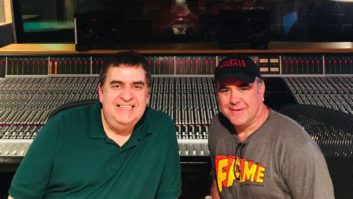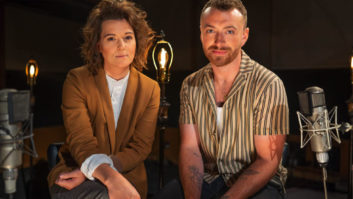A shift has slowly been taking place in the Manhattan advertising community over the past several years, and increasingly, it involves a trip down to the Flatiron district, where agencies and their suppliers are migrating in search of cheaper rents and large, airy loft spaces. Several months ago, a trio of established sound designers and mixers opened up an audio post facility to service the ad biz, leaving things loose enough so that record projects could find a comfortable home there, as well. These three-mixers Tom Jucarone and Peter Holcomb and sound designer Marshall Grupp-joined Peter Corbett, the founder of Click 3X, a consortium of visual effects houses, as partners in Sound Lounge.
Located on Fifth Avenue and 22nd Street, close to the New York branch of Click 3X, Sound Lounge has been designed for comfort and workflow. The facility includes a large space for recording live bands and an edit room for Sound Lounge jack-of-all-trades Philip Loeb, in addition to production/post rooms for the three principals. Holcomb, lead mixer at New York’s Photomag before going into business for himself, says, “Tom and I each have six 4×6-foot windows in our rooms, and the way gazing out of them tends to put everyone at ease is really special. As everyone knows, the advertising industry runs on brutal deadlines and pressure. Being able to witness the passage of time, to see the day go by in front of you, is great. Clients love it, and so do we.”
The centerpiece of Holcomb’s room is a Soundtracs DPCII digital console, and he says that despite the plethora of digital boards out there now, the choice was easy. “To tell you the truth, I didn’t really consider any other board,” he says. “I’d been using an AMS Logic 2 for two or three years, so I was very familiar with digital consoles. I really don’t think there’s another console on the market that can touch the DPCII at its price point. The board has 160 inputs and 40 outputs, which is perfect for our needs.
“The DPCII seems to fill the void between small digital consoles like the 02R, and the SSL Avants and Logic 2s,” Holcomb continues. “There’s really nothing else in that midrange. Of course, it has total recall and dynamic automation, and it really sounds great. The EQ sounds ‘fat’ and ‘warm,’ which I know are overused terms, but they apply here. The board sounds big.”
Any board that has six buses can call itself a surround sound console, but a mixer needs to monitor across all of the buses rather than simply have them available to hang speakers on. Holcomb says the DPCII monitoring is excellent. “It’s a true surround sound board,” he explains. “You can pan anywhere-even into the subwoofer if you want to. It has a 40×8 monitoring matrix built into the newest software releases, and it’s very flexible, intuitive and easy to learn.”
Studios designed for stereo mixing have to confront retrofits to handle 5.1 mixing, but new facilities like Sound Lounge have the advantage of constructing space with multichannel playback in mind. “My idea was to build a mixing environment that was like someone’s home theater room, with a console sitting in the back,” Holcomb says. “My clients are all in front of me, as is the speaker array [currently five JBL LSR 28s plus a subwoofer] and the large-projection screen. We hang out and roll picture like we were in our living room.”
Sound Lounge relies exclusively on Sony PCM-800s when working with tape, figuring that material will come in on the Tascam DA-88 format. Final layback is to D1. Traditionally, audio post houses send that D1 on down the line to a video house, where final masters have been assembled, but Holcomb says that the Sound Lounge is now generally the last stop in the process. “We make 3/4-inch dubs for client screenings, but the relays we lay off to D1 generally go directly to dubbing houses, and then on to homes all across America! We almost always get the final picture on D1.”
Tom Jucarone is equally jazzed about the analog console in his room, as it fits his style of working. “I love the sound of analog,” he says, “and I like to stay analog as far into the mixing process as possible. The Harrison Series-Twelve console I’ve got in my room is perfect for me. It has a digitally controlled surface, and unless you knew it was an analog board, you wouldn’t notice the difference between it and any of the digital consoles that are currently in favor. I’ve had the board since we opened in late September, so I’m still learning it, but it’s very intuitive; with two hours of training I was able to start mixing on it.”
The two main mixing rooms at Sound Lounge, plus Marshall Grupp’s sound design room, are all equipped with Fairlight MFX3 workstations. “Fairlight seems to be making all the right moves now,” Holcomb says. “They’ve got the networking aspect nailed, and that’s very important for us.”
How about working in the 24-bit realm? “As soon as the Fairlight goes 24-bit, I’m throwing one of those 24-bit DAT recorders in my room; my Soundtracs is standing by-it’s ready to go 24-bit. I’m not that interested in the 96k issue. To me, upping the bit rate is more important.”
Finally, recognizing that much of the audio world lives with Pro Tools, Sound Lounge has a Pro Tools 24 system in Phillip Loeb’s room. Holcomb explains that “the Fairlight can read Digidesign files, so Phillip will often take Pro Tools tracks and prep them for transfer to one of our MFX3s. He also handles our ISDN work, as well as the transfers of material that come to us on DAT or DA-88 tapes. Phillip also does a great job helping Marshall. We have a Foley room, and we also record ADR, so on any given day he’ll be assisting on a variety of projects.”
Yes, Sound Lounge has a lot of toys, and a nice blend of analog and digital technology, but the equipment is secondary to the personal aspect of the partnership, according to Jucarone. “Peter and I have known each other for many years, and we have a great connection. It just seemed natural that we should be working together, and we’re looking forward to keeping the relationships we have with our existing clients, and establishing new relationships as well.”






